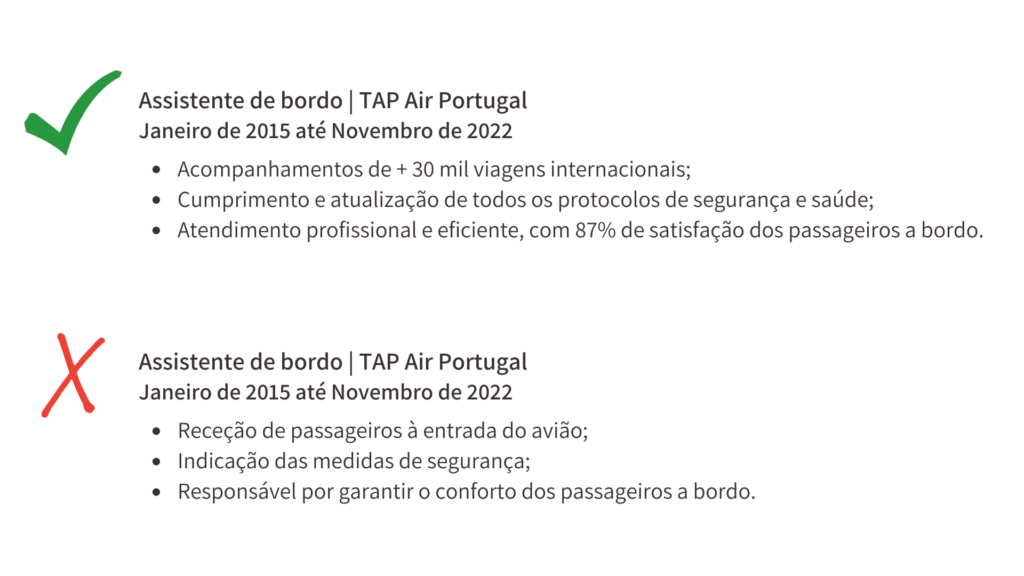How to create a Curriculum Vitae (CV)? Which model to choose? What to pay attention to and what mistakes to avoid? Follow our tips and feel confident when sending your resume.
The resume is the gateway to a new job. It works as a personal marketing document from which recruiters evaluate, screen and select. Therefore, it is important to ask yourself: “Is my CV well written?”
When you apply for a job, it is natural that dozens, if not hundreds, of other applications reach the recruiter. In order not to be discarded and stand out among so many others, you must do a simple, concise CV that reflects your professional trajectory in a clear and objective way.
Furthermore, if the objective is to move on to the next stage, you must do your homework and adapt your CV to the vacancy and company you want to work for. There is no ideal CV, because each employer will look at it and analyze it depending on their needs and interests.
Do you want to put these ideas into practice? Do you want to be called for the interview and show your value? So pay attention to our tips.
1. How to choose the correct model
When writing your CV, you have several options:
- You can use the tools available in word;
- Download a template on a website;
- Create it in a online platform, like Canva, which offers several templates;
Understanding which model is most suitable has a lot to do with the type of vacancy, place of work and even the country you are applying for.
For institutional positions, for example in European government organizations and similar agencies, the Europass model It is the most used and is still preferred among recruiters. In countries like France, applications that use this type of model are not even considered.
In other professions in Portugal, the tendency is to submit one-page CVs, with a strong graphic identity and personalized to each application.
Regardless of the model used, the simpler the better. Choose to present professional experience, qualifications and courses in chronological order. The resume must be easy reading It is should not take more than two pages. Even if you have more than 10 years of experience, be concise and only present information that is relevant to the position you are applying for.
2. Photography: yes or no?
Once again the answer depends on the type of position. In professions that value skills more than appearance, the use of personal photographs on CVs is not always viewed favorably and can lead to situations of discrimination.
On the contrary, in professions linked to fashion, beauty, customer service, tourism and events, the image is an element considered relevant, and, therefore, it makes sense to include photography in the curriculum vitae.
The truth is that there are vacancies that prohibit it and others that specifically ask for it. If in doubt, read the offer carefully, and, if you don't get the information you need, be guided by the vacancy profile.
Always indicate the link to your Linkedin profile, if recruiters want to research more about you and find out what you look like.
3. Who is it? What it does?
Besides the personal information, which should only be essential (name, contact, city of residence, email, Linkedin profile, blog/website), reserve a space at the beginning of the CV to presentation.
Briefly describe your professional career, your greatest achievements, your future goals and why you fit into the vacancy or position you would like to work in.
Also specify your occupation area in a prominent place and in a few words. This way, you are communicating quickly and generically what you know how to do and where you can work. Some examples:
- Hotel Reception and Accommodation
- Tourist Entertainment and Interpreter Guide
- Event Management, Activity Planning and Logistics
- Human Resources and People Management
The area of activity should not be confused with the desired position (for example, cruise receptionist, cultural animator, human resources director, etc.).
4. Add keywords that can be tracked
Typically, during the hiring process, resumes usually go through a Applicant Tracking System (ATS), before being analyzed more closely or being selected for the interview phase.
The ATS analyzes the digital formatting of the CV and the keywords used. It is the first phase that the curriculum goes through. Next, it is the human resources professional or hiring manager, who will look for specific requirements and preferences for the job you are looking to fill.
What happens is that in the midst of so many CVs, not only the Tracking System, but also the recruiters themselves make a text scanning looking for keywords that stand out. Therefore, you should bet on strong keywords, which clearly and objectively describe skills, qualifications and experience.
5. Avoid large blocks of text and get creative with colors
In the digital age, people like content with a appealing and easily digestible design. Recruiters are no exception to this rule.
The first screening of CV's can only take a few seconds to find what they are looking for. Therefore, avoid blocks of dense text. Get straight to the point and organize the information by easy-to-learn schemes at first glance.
Use colors strategically to create a visual impact. Choose no more than two shades for the name, contact and section titles. Be creative, but don't overdo it. The ideal is balance conservative tones with modern design elements.
6. List achievements, not tasks performed
Professional experience is one of the most important sections of the resume. It must contain the positions in which you worked, the name of the company, the start and end date of the contract and a description of the activities you carried out.
It is in this last part that special care is recommended. How to describe what you did in previous jobs?
Here you should not simply list your responsibilities. Especially because it presupposes from the outset which tasks are compatible with certain positions.
No, what we want to know is how he performed these tasks, What achievements and results have you achieved?. But don't list just any achievement, list the one that will make a difference to the position you are applying for.
An example could be:

7. Also include extra qualifications
Do you have computer or language skills that could be useful? Create a section for skills and abilities.
The ideal is to prioritize the presentation of hard skills, such as fluency in English and French, in relation to soft skills, such as good communication skills or exceptional interpersonal skills.
The skills listed must be adapted to the position you are applying for and show all the potential and difference you can offer to the team you are joining.
If there are others courses or workshops not placed in the training section, take the opportunity to create a space for them too. Again, only list courses that might interest your recruiters.
8. What to add if you have no experience?
If you do not yet have professional experience or want to pursue another area in which you have never worked, you can highlight other experiences that are relevant. Some examples:
- Volunteering: Even if it is not in activities linked to your professional field, volunteering reveals proactivity and a desire to develop personally and professionally, something highly valued by recruiters.
- Extracurricular activities: courses, workshops, participation in lectures or other experiences, such as Erasmus, joining a student association, organizing group activities, show that you are looking for learning and have a well-defined career focus.
- Hobbies: There are hobbies that may be well regarded by your recruiters because they are directly linked to the area in which you want to work. If the objective is to work in the field of sports, for example, you could mention on your CV that you belong to an athletics team and are taking tennis lessons. This is also a way to show your interests and make yourself known.
9. Review, review and review
Many recruiters cannot tolerate meeting linguistic errors on CVs and this can serve as one of the first exclusion criteria.
Make a detailed review of everything you wrote, if necessary several times, because it is possible to find writing errors with each new reading. If you are still unsure, ask someone to read and analyze it, the important thing is to send it confident that there is no problem with it.
10. Update your resume for each vacancy
Finally, don't forget to update your curriculum vitae if you change your address or contact details. Add courses, lectures you have attended or experiences that can be valued. Recruiters may notice empty blocks of time, so be careful.
Free template
To make the task of creating the perfect CV easier for you, we offer a pre-made template, with all the sections you need and a unique and creative design.
All you have to do is fill in the blanks, follow our tips and go to the interview phase, where you will be able to show your full potential and get the job you want.

Resume
Free template
After filling out the form, a pop-up will appear with the free template.

